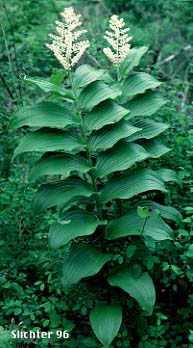 Characteristics:
Characteristics:
False Solomon seal is an attractive perennial wildflower. The stout flower stems arise 30-90 cm high from a network of rhizomes. The herbage ranges from somewhat glabrous to finely haired. The 8-16 leaves alternate along the stems and are ovate to ovate-oblong or ovate-elliptic in shape with the blade narrowing gradually to a point. The base of each blade is sessile or clasping and the leaves range from 7-20 cm long and 4-8 cm wide. The venation is parallel and the entire margins may be somewhat wavy.
The inflorescence consists of numerous small white flowers in a freely branched panicle from 3-12 cm long. The tepals are narrowly oblong in shape and about 1.5 mm long. The stamens are about 2.5-3 mm long and ovate-lanceolate in shape. The stamens are generally much wider than the tepals. The fruit is a globose reddish berry from 5-7 mm in diameter.
False Solomon seal is a pretty wildflower suitable for the woodland garden. Due to its height, it is probably best utilized in the middle or back of flower beds or it can be planted next to the trunks of trees or intermittently through the woodland.
False Solomon seal is a plant of most shady woods, streambanks, and open forests from near sea level to medium elevations in the mountains. East of the Cascades it may be found in open riparian areas or moist streambanks and even occasionally on higher prairie ridgetops. In such situations it is generally much reduced in size and may even be confused with its smaller cousin, star-flowered false Solomon seal.
False Solomon seal may be found from Alaska to California and east to Nova Scotia and south to Georgia, Mississippi, Missouri, Colorado and Arizona.
In the Columbia River Gorge it may be found between the elevations of 100'-4000' from Troutdale, OR east towards Mosier, OR.